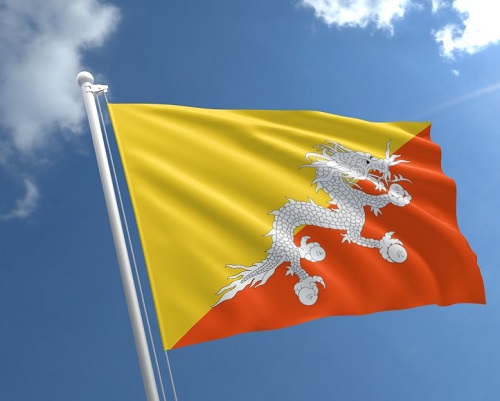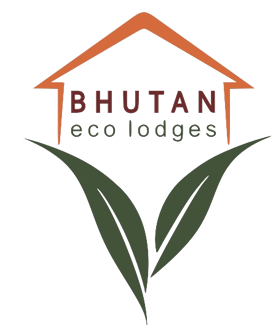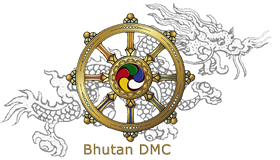Bhutan Facts
Geography
The princely Kingdom of Bhutan is a landlocked country, about 300 km long and 150 km wide encompassing an area of 38,394 square kilometres and spreads between meridians 89°E and 93°E, and latitudes 27°N and 29°N. It is bordered by India in South and South-West and Tibetan autonomous region of China in the North and North-West respectively. Virtually the entire country is mountainous, and ranges in elevation from 100m along the Indian border to the 7,554m Kulha Gangri peak on the Tibetan border. These two extremes frame a landscape which stretches from sub-tropical to arctic like conditions. The maximum East-West stretch of the country is approximately 300 km and north-South about 150 km.
Physiography
Talking in geomorphologic terms, Bhutan is distinctively divisible into three lateral zones from South to North. Incidentally, this zonation is more or less applicable to meteorological, ethnographical and geographical divisions of the country.
The Great Himalaya
Extending from Mt. Chomolhari (7,314m) in the West to Kulha Gangri (7,554m) near the center point of the northern border between Tibet and Bhutan, this region is virtually a snow-wilderness zone where almost 20% of the land is under perpetual snow. This zone is represented by alpine meadows and perpetually snow bound high summit of the Great Himalayan range.
The Inner Himalaya
This is the largest physiographic region of Bhutan and lies among broad valleys and forested hillsides from 1,100m to 3,000m in elevation. All the major towns of Bhutan are situated in this zone such as Paro, Thimphu, Punakha, Wangduephodrang, Haa valley, Gangtey & Phobjikha in western Bhutan, Trongsa and Bumthang in central Bhutan and Mongar, Trashigang, Trashiyangtse and Lhuntse in eastern Bhutan.
The Southern foothills
Also called as Himalayan foothills, this zone occupies the southern-most part of the country. The plains in the south of the country are part of the region known as Terai, which extends from Kashmir, through Nepal, to Bhutan. The average annual rainfall in this region generally reaches up to 200 inches resulting to luxuriant vegetation particularly tropical forests rich in wildlife, while at times hot, steamy and unhealthy tracts are other features of this zone.
Drainage
Rivers play an important role in Bhutan's physical, economic, social and cultural geography. Their enormous potential for hydroelectric power has helped in shaping the national economy. Since the central Himalayas of Bhutan receives the full brunt of the monsoon so the rivers are larger and have created much broader valleys than rivers further to the west in Nepal and India. In their upper reaches, most Bhutanese rivers have created large fertile valleys such as those of Paro, Punakha, Wangduephodrang, Thimphu and Bumthang. As the rivers pass through the centre of Bhutan, the valleys become steeper and narrower, and roads have to climb high on the hillside. The principal rivers of the country are Am-mo-chhu, Paro Chhu, Wang Chhu, Puna-Tsang Chhu, Mangde Chhu, Pho Chhu, Mo Chhu, Dangme Chhu, Manas Chhu and Changkhar Chhu.
Meteorology
Bhutan's climate varies widely depending upon elevation. In the southern region it is tropical, with a monsoon season and eastern part is warmer than the west. The central valleys of Punakha, Wangduephodrang, Mongar, Trashigang and Lhuntshi enjoy a semi-tropical climate with cool winters, whereas Paro, Thimphu, Haa valley, Gangtey, Trongsa and Bumthang have relatively harsher climate including snowfall in winter. In the valleys where most tourist activities are concentrated, the winters (mid-November to mid-March) are dry with daytime temperatures of 12 – 14 degree centigrade while evening and early morning are cold with night time temperature sometimes falling below zero. Spring lasts from mid-March to the beginning of June, with temperatures warming gradually to 27-29 degree centigrade by day and about 16 degree centigrade at night. However, cold spells are possible up until the end of April, with a chance of new snow on the mountains above the valleys. Strong, gusty winds start blowing almost every day from noon to early evening. The first storms break, and they become more and more frequent with the approach of the monsoon which arrives in mid-June. The country receives abundant rain especially in the south, as it gets full face of monsoon coming from the Bay of Bengal. To which its mountains form a barrier. At the end of September, after the last of the big rains, autumn suddenly arrives and sky gets clear, a brisk breeze picks up and temperature starts falling towards freezing at night although bright sunshine continues to keep the days warm. Autumn is the magnificent season that lasts until mid-November and it is one of the best times to visit this fascinating mountain Kingdom.
The History
Being a landlocked country, the history of Bhutan has always been influenced by its geography. The name 'Bhutan' appears to derive from the Sanskrit 'Bhotant' meaning 'the end of Tibet' or from 'Bhu-uttan' meaning 'high land'. Though known as Bhutan to the outside world, the Bhutanese themselves refer to their country as Druk Yul or the Land of the Thunder Dragon. 'Druk' meaning 'Dragon' and it is extending from the predominant Drukpa school of Tibetan Buddhism. The documented history of the Kingdom begins with 747 A.D. with Guru Padmasambhava also known as Guru Rinpoche who made his legendary trip from Tibet across the mountains flying on a tigress's back. He arrived in Paro valley at Taktsang Lhakhang also known as Tiger's Nest. Guru Rinpoche is not only recognized as the founder of the Nyingmapa religious school but also considered to be second Buddha. In the ensuing centuries, many great masters preached the faith resulting in full bloom of Buddhism by the middle ages. Although sectarian at first, the country was eventually unified under Drukpa Kagyupa sect of Mahayana Buddhism by saint/administrator Shabdrung Ngawang Namgyal in the 17th century. Ngawang Namgyal codified a comprehensive system of laws and built a chain of Dzongs which guarded each valley during unsettled times and now serving as the religious and administrative centre of the region. During the next two centuries civil wars intermittently broke out and the regional Governors became increasingly more powerful. At the end of 19th century, Trongsa Governor overcame all his rivals and soon afterwards recognized as the overall leader of Bhutan. The Governor of Trongsa, Sir Ugyen Wangchuck, was elected as the first King of Bhutan in 1907 by an assembly of representatives of the monastic community, civil servants and people. Since then, the country has been ruled by successive monarchs of the Wangchuck dynasty. In November 2001, on the advice of the Fourth king, a committee chaired by the Chief Justice of Bhutan, was formed to draft the constitution of Bhutan. The constitution was launched in 2008 and with it a parliamentary democracy introduced. The progression from hereditary monarchy to that of a Parliamentary Democracy has been a carefully managed process that culminated in 2008 when Bhutan held its first elections country wide. Since 18 July 2008, Bhutan has a two-chamber parliamentary system: The Upper House of parliament, the 25-seat National Council, and the Lower House of Parliament (National Assembly – Tshogdu) with 47 seats. The government is headed by a Prime Minister and the King is still head of state.
The People
Bhutan's population is, in many ways, one large family. About 70 percent of the people still live on subsistence farming, scattered in sparsely populated villages, across the rugged terrain of the Himalayas. Since early days, Bhutanese communities settled in the valleys with limited communication from outside word and perhaps it is for this reason that the sense of individuality and independence emerges as a strong characteristic of the people. The Bhutanese are, by nature, physically strong and fiercely independent with open and ready sense of humour. Hospitality is an in-built social value in Bhutan. The estimated population of the country is about 7,44,000 and three main ethnic groups constitute its population: Sharchops: live in eastern part of country, recognized as the original inhabitants of Bhutan and are of Indo Mongoloid origin. Ngalops: are descendants of Tibetan immigrants who arrived in Bhutan from 9th century and settled in the west of country. Lhotshampas: this Nepalese group, began settling in the south of Bhutan in the late 19th century. The Lhotshampa represents different Nepali speaking ethnic groups primarily – Brahman, Chettri, Gurung, Rai and Limbu.
The Economy
The roots of Bhutan’s economy remain in its natural resources with agriculture and forestry, being the main livelihood for more than half of the population while harnessing of its strong, swift-flowing rivers for generation of hydroelectric power has been also an important key to its economic growth. The service sector is growing rather rapidly in modern times with travel industry being the major contributor.
Bhutan’s economy is one of the smallest yet fastest growing economies of the world and for little more than a decade average economic growth has been 7.6% thus far exceeds world’s growth rate of 3.2%. Extreme poverty is almost eliminated based on figure of international poverty line. Access to basic services such as health, education and asset ownership has also improved significantly. The current national literacy rate is 71% and youth literacy rate is 93%.
Because rugged mountains dominate the terrain and make the building of roads and other infrastructure difficult and expensive, industrial production is primarily of the cottage industry type. The Bhutanese economy is closely aligned with India's through strong trade and monetary links and is dependent on India for financial assistance and migrant laborers for development projects, especially for road construction. India accounts for more than 80% of Bhutan’s internal trade.
Multilateral development organizations administer most educational, social, and environment programs, and take into account the government's desire to protect the country's environment and cultural traditions. Bhutan's overall development strategy is assessed according to the expected impact on the Gross National Happiness indicator, by focusing on providing the population with basic needs, maintaining social cohesion and pursuing sustainable environmental policies.
The most important sectors of the economy remain hydroelectricity, tourism and agriculture. The government has focused on the development of 'low volume, high quality tourism', as a way to protect the environment and mitigate the impact of disrupting influences on the domestic culture. Its largest export – hydropower to India – is creating employment and will probably sustain growth in the coming years. It also exports calcium carbide, wood products and cement. In other major export is agricultural product, including apples, oranges, cardamom, potatoes, asparagus, mushroom. Bhutan hopes to play a larger role in regional economic integration as a member of the South Asia Association for Regional Cooperation and the Bay of Bengal Initiative for Multi-Sectoral Technical and Economic Cooperation.
Bhutan’s economic development policy continues to be guided by the overarching philosophy of Gross National Happiness (GNH) based on the four pillars of sustainable economic development; preservation and promotion of culture and tradition; conservation of environment; and good governance. Hydropower, agriculture, tourism, small & cottage industries and mining are mainly five jewels of Bhutan’s economy.
Hydropower
Hydropower, a strategic national resource, is main driver of Bhutanese economy and country has potential upto 30,000MW of which 23,760 MW has been identified as economically feasible. The export of power is by far the most important component in Bhutan’s foreign trade balance. The development of this sector is key in achieving sustainable economic self-reliance and towards this, development of hydropower have a three-pronged objective of i) meeting the nation’s domestic energy security, ii) promoting industrial growth and iii) enhancing revenue. Acknowledging the potential, the Royal Government has declared hydropower as one of the five jewels of economy. Efforts also targeted to build capacity towards becoming a knowledge centre for hydropower development and related services both in the region and globally.
The first mini hydropower project was commissioned in 1967 and later in 1986 the first mega project, Chukha Hydropower plant with 360MW capacity was commissioned. Then in 2006, another milestone in the power sector was achieved with the launch of1020 MW Tala hydropower project. Bhutan is currently exporting the excess of its hydropower of over 1500 MW to India out of its total present production of around 2000MW. Currently, there are three Hydropower projects under implementation in association with India: 1200 MW Punatsangchhu-I, 1020 MW Punatsangchhu-II and 720 MW Mangdechhu. By 2022, the Royal Government aim to achieve a minimum power generation of 5000 MW.
Agriculture
The agriculture sector considered one of the ‘five jewels’ of Bhutan’s economy, employing about 56% of the population and its contribution to nation’s GDP is about 18%. Country’s major agricultural products are maize (and other cereals), rice, potatoes, citrus, milk, eggs, and spices such as cardamom and ginger. The major horticultural exports are citrus (mandarin), potatoes, chilies, areca nuts, cardamom, and ginger, and several niche crops are also produced or gathered (mushrooms, honey, asparagus, hazelnuts, black pepper, and Sichuan pepper). Bhutan is endowed with diverse ecosystems owing to natural occurrence of complex physiographic and climatic settings. These diverse ecosystems provide a basis to social, economic and cultural developments of the country. Specific to the sector forestry, agriculture and livestock developments take place within these ecosystems. Dairy animals, pigs and poultry also play a valuable part in rural economy.
Tourism
Since its inception in 1974, tourism industry in Bhutan has made a significant contribution to the socio-economic development of the country through revenue and foreign currency generation and employment creation. Internationally Bhutan is well applauded as a sustainable tourism destination guided by principle of ‘High Value & Low Volume’ tourism, targeting mindful and responsible visitors, creating good value for money experiences, high revenue and yield, quality infrastructure and tourism products and services. In the year 2019, USD 345.88 million worth of tourism businesses conducted in the country and tourism’s contribution to country’s GDP have been about 10%.
Cottage & Small Industries
Cottage and Small Industries (CSI) constitute more than 96 percent of the total number of industries. As of now, the sector remains dominated by the service and contract sector with a very small manufacturing base. There is therefore the need to boost development of CSIs as it has the potential to promote regionally balanced development, create jobs and inculcate entrepreneurship in society. For this the government has developed an action plan to, expand small enterprises throughout the country.
Mining
Bhutan’s mineral resources include dolomite, limestone, coal, graphite, gypsum, marble, lead, zinc and copper. There are currently 24 active mines and 40 quarries in the country covering 3,319.86 acres. Mining plays an important role in supply of raw material for the mineral based industries, infrastructure and other development projects. The Royal Government of Bhutan endeavours that mineral resources are utilized in a sustainable manner to diversify the economy as it forms an integral part of the supply and value chain to industries.
Health & Education
As a component of Gross National Happiness, affordable and accessible health care is central to the public policy of Bhutan. The Ministry of Health has provided universal health since the 1970s and Health care infrastructure & services are planned and developed through Five Year Plans (FYP) of the Ministry of Health. The concept of health in Bhutan must be seen in the context of the overall development strategy that defines development as the preservation of spiritual and emotional, as well as economic well-being. The focus of health sector has been to increase the accessibility to health care. Basic health care services and essential drugs are provided free of charge. Therefore, the health sector policy objectives reflect the national ones: equity, social justice, sustainability and efficiency, in the context of preservation of national culture. The long-term objective of the health services is to ‘facilitate, through a dynamic professional health care, the attainment of a standard of healthy living by the people of Bhutan to lead a socially, mentally and economically productive life, and within the broader framework of overall national development, enhance the quality of life of the people in the spirit of social justice and equity’.
The 'traditional' education system in Bhutan has two major components, the ecclesiastical oriented institutions and the state led general or secular education. With the advent of Buddhism in Bhutan in the 8th century, monastic schools came to play an important role in the lives of the people and it continues today. The modern, western form of education was introduced in Bhutan in 1950s. The western education has been promoted and expanded since the first Five Year Plan in 1961 corresponding to the embarkation of modern development in 1961 to address the basic educational needs, and develop human resources required for the socio‐economic development of the country. The Non‐Formal Education system, to deliver basic literacy and numeracy skills in Dzongkha, was introduced in the country in 1990 to reach out to the dispersed and marginalized groups, especially women. A Continuing Education program to provide opportunities to adults who could not complete their education was piloted in 2006 in Thimphu and has since been expanded. Besides the education provided within the country, many Bhutanese receive the opportunities to pursue education outside the country. Prior to the initiation of tertiary education programs in 1983, all qualifying Bhutanese were sent abroad, mostly to India, to obtain their tertiary education. Even now, many Bhutanese obtain their tertiary education degrees outside the country through government arranged scholarship. Moreover, because of the lack of capacity within the country, increasing numbers of Bhutanese are travelling outside the country to get their education through self-financing.
National Symbols
National Emblem 
The National Emblem of Bhutan is a circle, projecting a double diamond thunderbolt placed above the lotus. There is a jewel on all sides with two dragons on vertical side. The thunderbolt represents the harmony between secular and religious power while the lotus symbolizes purity. The jewel signifies the sovereign power while the dragons (male and female) stands for the name of the country Druk Yul or the Land of the Dragon.
National Flag
The National Flag is rectangular in shape that is divided into two parts diagonally. The upper yellow half signifies the secular power and authority of the King while the lower saffron orange symbolises the practice of religion and power of Buddhism, manifested in the traditions of Drukgpa Kagyupa. The dragon signifies the name and purity of the country while the jewels in the claws stand for wealth and perfection of the country.
National Flower
The National Flower is Blue Poppy (Meconopsis Grandis), a delicate blue or purple tinged blossom with a white filament. It grows to a height of one meter, on the rocky mountain terrain found above the tree line of 3500-4500 meters.
National Tree
The national tree is Cypress (Cupressus torolusa), found in temperate climate zone between 1,800 and 3,500 meters. Its capacity to survive on rugged harsh terrain is compared to bravery and simplicity.
National Bird
The national bird is Raven and represents the deity Gonpo Jarodongchen (raven headed Mahakala), one of the chief guardian deities of Bhutan. The Raven, national bird also ornate the royal crown.
National Animal
The Takin (burdorcas taxicolor) is the national animal of Bhutan, looking like a cross between a cow and goat and associated with religious history and mythology of the country.
National Day
17th December is celebrated as the National Day that coincides with the crowing of Gongpa Ugyen Wangchuk as the first hereditary King of Bhutan, in Punakha Dzong on 17 December 1907.
National Anthem
The national anthem was first composed in 1953 and became official in 1966. It is known as Druk Tshenden Kepay Gyalkhab Na (In the land of the Dragon Kingdom, where cypress grows). It is religious in essence with lyrics consisting of prayers for peace and prosperity in the country, long life of the King and propagation of Buddhism.
National Language
The state language is Dzongkha which in the olden times was spoken by people who worked in the Dzongs that was seat of temporal and spiritual power. Later, Dzongkha was declared as national language of the country. Today, about 18 languages and dialects spoken all over the country.
National Sport
Archery was declared national sport in 1971 when Bhutan became a member of United Nations. Archery tournaments are among the most picturesque and colourful events in the country. Every village has its own archery range. High spirited competitions, usually accompanied by a banquet, are a part of all festive occasions.
National Dress
The national dress of Bhutan is called the 'Gho' for men and 'Kira' for women. It was introduced during the 17th century by Zhabdrung Ngawang Namgyal to give the Bhutanese a unique identity. The Gho is a long robe hoisted to the knee and held in place with a 'Kera,' a woven cloth belt, wound tightly around the waist. The Kira is a floor-length rectangular piece of cloth wrapped around the body over a blouse called wonju. The kira is held from the shoulders by broach-like hooks called 'Koma' and is fastened at the waist with a kera. The dress is complete with a short, open jacket-like garment called 'Toego.'
HOTELS IN THIMPHU
HOTELS IN PUNAKHA & WANGDUE
HOTELS IN GANGTEY
HOTELS IN TRONGSA
HOTELS IN BUMTHANG
HOTELS IN MONGAR
HOTELS IN TRASHIGANG
HOTELS IN SAMDRUP JONGKHAR
HOTELS IN PHUENTSHOLING
HOTELS IN HAA
HOTELS IN GELEPHU
HOTELS IN ZHEMGANG
RESTAURANTS IN PARO
RESTAURANTS IN THIMPHU
RESTAURANTS IN PUNAKHA
TOUR ITINERARIES
TREKKING ITINERARIES
SPECIAL INTERESTS TOURS
UNIQUE FESTIVALS & FAIRS
BLOG


